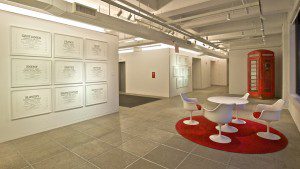Architectural Photography in New York: Inside Ogilvy’s Historic Hell’s Kitchen Building
 Gaining Access to Exclusive Commercial Spaces
Gaining Access to Exclusive Commercial Spaces
I was fortunate to gain access to the Ogilvy building in Hell’s Kitchen through my friendship with Yeesan—a rare opportunity to photograph this converted chocolate factory near the Hudson River. These personal connections often provide photographers with access to spaces typically closed to the public, creating unique portfolio opportunities.
Yeesan, who works for renowned architecture firm Gensler, was instrumental in the building’s refurbishment. Her contact there, Cynthia, provided exceptional assistance throughout the shoot, though I suspect she questioned my sanity when I proposed rooftop photography in approximately -7°C temperatures with punishing winds—perhaps rightfully so.
Exploring Interior and Exterior Architectural Photography
I’m increasingly drawn to architectural photography, a discipline that encompasses both interior and exterior spaces with equal importance. As Architectural Digesty , this specialized field requires understanding design principles alongside photographic technique. It’s a fascinating specialty with distinct conventions and expectations that differ from other photography genres.
Through experience, I’ve learned what approaches are considered acceptable within architectural photography’s relatively conservative standards. For instance, the acute angles and downward perspectives I might employ when photographing retail spaces would likely be rejected in more traditional architectural documentation, where straight lines and perspective control remain paramount.
Technical Approaches to Commercial Space Documentation
For this assignment, I specifically purchased a tripod—rediscovering the benefits this essential tool provides. This might seem like an obvious choice, but when primarily photographing people in dynamic situations, tripods often become impractical. I’ve grown accustomed to working quickly with handheld techniques that prioritize mobility and responsiveness.
The tripod’s ability to slow down the photographic process proved surprisingly refreshing, creating space for more deliberate composition and technical precision. This methodical approach is essential for quality architectural work. The stability also eliminated the physical strain of contorting into awkward positions to achieve specific angles—a common challenge when photographing interiors.
My technical plan included capturing bracketed exposures for potential HDR processing or manual exposure blending in post-production. However, relatively few images ultimately benefited from this approach. I remain cautious about HDR techniques, which often produce superficially impressive but ultimately unconvincing results when overused, as discussed in Fstoppers’ article on architectural photography techniques .
The Meditative Quality of Architectural Photography
Spending several hours photographing spaces without human subjects created an unexpectedly meditative experience. The day passed with remarkable speed as I entered a state of complete focus—so immersed in the work that I realized afterward I had neither eaten nor drunk anything for approximately seven hours.
This intense concentration represents one of architectural photography’s unique rewards—the opportunity to work methodically and precisely without the unpredictability of human subjects. After completing the shoot, my priorities shifted immediately to finding a venue serving quality New York cocktails and much-needed sustenance—the perfect conclusion to a creatively fulfilling day documenting this historic space.
